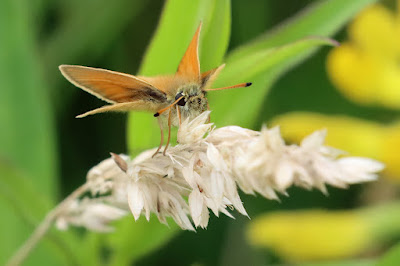In this blog post, Roy Lowry reviews his photo recording visits to the Butterfly Park in 2023.
During the year I logged a total of 628 observations, which I have now compiled in a spreadsheet to provide an overview. I classified them into 22 categories (ants, bees, other beetles, birds, bugs, butterflies, damselfies, dragonflies, other flies, grasshoppers, hoverflies, isopods, ladybirds, mammals, moths, plants, sawflies, slugs, snails, soldier flies, spiders, spittlebugs, and wasps). Over half of the observations belonged to just three groups, namely bees (81), butterflies (114) and hoverflies (171), so I will concentrate on these for the rest of this summary.
I find bees the most difficult of these groups to record because of the lack of accessible identification support. Bee records submitted to iRecord are very rarely verified and whilst the community approach of iNaturalist can be helpful it can also be disruptive, especially when identifiers fail to take account of differences between bee populations in the UK and elsewhere in the world. Consequently, I am trying to develop my bee identification skills with excellent support from the Cheshire Bee Group and the Tanyptera Project who also help with identifications should I come across anything particularly interesting. Recording hoverflies and butterflies is much easier because all records submitted to iRecord are verified within a couple of weeks or even a couple of days.
Because of the identification uncertainties I can't precisely report the bee species diversity, but it is possible to give an overview based on genus-level identification. During the year I recorded six 'types' of solitary bee in addition to the social honeybees and bumblebees. In early spring there were flower bees (Anthophora) and mining bees (Andrena), followed by mason bees (Osmia), plasterer bees (Colletes), leaf-cutter bees (Megachile) and furrow bees (Lasioglossum). In addition there were cuckoo bees (Melicta, Nomada, Coelioxys and Sphecodes) whose host preferences covered most of the solitary bees seen.
The highlight of the bee recording was the sighting of a male red-girdled mining bee (Andrena labiata) in April. This is quite a rarity with only five records for the Cheshire recording area (which includes Wirral) in iRecord and no other records north of Birmingham in INaturalist. As it was so unusual I had the ID checked and confirmed. I kept a careful lookout after this for any other sightings, preferably of a female, but to no avail. I'll continue the search in 2024 as this species is documented as one of many increasing its range northwards.
 |
| Male red-girdled mining bee Andrena labiata |
The hoverfly records were both numerous and diverse with 45 different taxa (species or genus not identifiable to species) logged. These included the four of the five large and spectacular members of the Volucella genus: two variants of the bumblebee hoverfly (Volucella bombylans), two species of hornet mimic (Volucella zonaria and Volucella inanis) and the black and white (almost transparent) pellucid Hoverfly (Volucella pellucens). This last species is a very noticeable resident of the Butterfly Park because the males are very territorial and spend their flight season (June and July) defending their territories against all comers, including people. There was one particularly aggressive specimen on the path between the pond and the lime waste who seemed to have a particular dislike for photographers with telephoto lenses.
 |
| Female yellow-girdled fleckwing hoverfly (Dasysyrphus tricinctus) |
My favourite hoverfly sightings of the year were a yellow-girdled fleckwing (Dasysyrphus tricinctus) in May and a gorgeous superb ant-hill hoverfly (Xanthogramma pedissequum) in September. I thought the fleckwing (called the yellow-girdled brusheye in iNaturalist) was a rarity. I hadn't seen one before but during the year I found them at Burton Mere and the Liverpool Festival Gardens so maybe they are just under-recorded. The superb ant-hill hoverfly is fairly uncommon (15 Cheshire records in iRecord), but the Butterfly Park is just the place to attract them with its large number of meadow ant nests. The larvae of this hoverfly develop in these nests feeding on the ants' fungus gardens.
 |
| Female superb ant-hill hoverfly (Xanthogramma pedissequum) |
Butterfly records were also pleasingly diverse with 20 species recorded (14 on a single day - July 19th), which was up from 16 in 2022. The four species added were the brimstone (Gonepteryx rhamni), Essex skipper (Thymelicus lineola), painted lady (Vanessa cardui), and small tortoiseshell (Aglias urticae). The first two of these were artefacts of my modus operandi because although I saw brimstones in flight and what I was convinced were Essex skippers I couldn't get the necessary photographic proof. This year the brimstones co-operated by landing in camera range and I managed to get Essex skipper pictures clearly showing the black antenna nudum. This verified the species and got New Ferry Butterfly Park formally recognised as an Essex skipper site.
 |
| Male brimstone butterfly (Gonepteryx rhamni) |
 |
| Male Essex skipper butterfly (Thymelicus lineola) |
The small tortoiseshell and painted lady were different stories. The former have been noticeably absent in the past couple of years so it was delightful to see one. I hope I will see more in 2024. The latter are migrants, arriving in the UK when favourable winds carry them from Africa and Spain. There were about half a dozen present on a single day and I also saw significant numbers in Mayer Park around the same time so I guess this was a migratory fall.
Possibly the most satisfying butterfly sighting was catching a couple of dingy skippers egg laying on patches of birds' foot trefoil, which means that this butterfly not seen in the area for 20 years until last year is now listed as a breeding species for the site.
 |
| Female dingy skipper butterfly (Erynnis tages) laying eggs |
New Ferry Butterfly Park has provided me with a most interesting year of invertebrate observation in both 2022 and 2023. I can't wait to see what 2024 brings.
